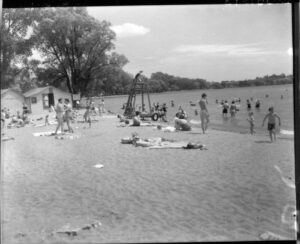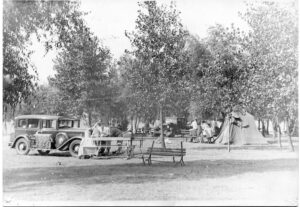Seneca Lake Park: From City Park to State Park
(From July/August 1997 Historical Society Newsletter)
From at least 1903, Geneva officials had maintained a bath house at the site of what is now Seneca Lake Park and had planted trees to make the space “a resort for the public.” By the early 1920s, with Lakeside Park finally developed, Geneva turned its attention to the land that had begun to interest it as early as 1898. In August 1922, the City held a special tax election to put to a referendum the question whether it should purchase the lands at the foot of the lake for a public park and bathing beach: the referendum passed. The City was authorized to spend $25,000 to acquire the shoreline from Pre-Emption Street, the eastern city limit, to the outlet bridge.
In 1924, the City bought thirty-five acres of former state canal lands for nearly $9,000 and bought more in 1925; in 1927, Genevans were again asked for permission to float another bond issue of $14,000 to buy land bordering the space in the towns of Waterloo and Fayette. Then, in August 1929, residents voted by a 452-205 margin to spend another $21,000 to buy the Greylock Inn and other parcels just over the City line. By then, the city had spent $68,972 to buy all the land from what was then O’Malley’s gas station to the barge canal.
By 1931, the beach in the City’s new Seneca Lake Park was used by hundreds in the summer. The City had established a tourist camp at the eastern end, as well as miniature golf links and a shuffleboard course. Several other businesses opened in the 1940s, including Danc’ Inn, Shelbe’s Hot Dog Stand, Dunham’s Fish Fry, Lou-Mar, and Club 5-20. But as the plans for the arterial became clear, the new park commission became concerned about the way the roadside across from the City park had developed.
In January 1952 Mayor Erie Rogers appointed the new commission to develop Seneca Lake Park, and within months commission members began to allege that the City had ignored the park for years, had used park maintenance funds for other purposes and had shown its lack of interest by abolishing the Park Board some years earlier. The park’s condition continued to worsen and in 1954 a pamphlet was issued urging Genevans to support making the City park a State park. The brochure contained photographs of current condition and declared the park “A Glorified Garbage Dump—A Decadent Trailer Park—An Unused and Unusable Beach—A Recreation Area with No Appeal—No Facilities—No Future.”
Arguments ensued—both for and against the bestowing of the park to New York State. The State would not initially consider the proposal because there was only two hundred acres and normally it would not consider making a state park on less than four hundred. The City was able to acquire additional property and returned to the state with their request. After two vetoes, the proposal was accepted in 1957 and by 1960 the City park became a State park.


